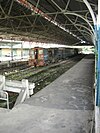Portal:Trains/Did you know/September 2012
Appearance
September 2012
[edit]- ...that although the term motorman, which was used to identify the person who operates an electrified trolley car, tram, light rail, or rapid transit train, was (and, where still used, is) gender-neutral, has been replaced by more neutral terms such as train operator (T.O.) on both the New York City Subway and London Underground?
- ...that as part of the Metropolitana di Napoli (Naples Metro) in Italy, the Montesanto Funicular, which originally opened in 1891, carries over 4 million passengers annually with an average of 12,500 passengers on workdays?
- ...that Light rail in Sydney, which originally opened in 1997 using the right-of-way of the former Darling Harbour Goods Line, is the only currently operating light rail line in Sydney, Australia?
- ...that Nagoya Municipal Subway's Meijō Line is the second loop subway line built in Japan, after Toei Ōedo Line, but the Ōedo Line, has a railway zig zag at Tochōmae, meaning the Meijō Line is the first (and currently the only) true loop subway line in the nation?
- ...that the original Maroon Creek Bridge, at the western boundary of Aspen, Colorado, United States, was designed by George S. Morison in 1888 for the Colorado Midland Railroad and was one of the last viaducts in Colorado built for a standard gauge mountain railroad in the 19th century?
- ...that the route for the Macclesfield, Bollington and Marple Railway, which opened in 1869 in England, was originally promoted in 1863 by Macclesfield businessman Thomas Oliver and was hoped to revive Bollington's cotton industry, carry the stone from quarries in Kerridge, and serve the collieries around Poynton?
- ...that Lokomotivfabrik der StEG, originally founded in 1839 by the Vienna-Raab Railway between the Vienna Südbahnhof and Vienna Ostbahnhof was the first Austro-Hungarian locomotive works, having been established with machinery from England and building its first designs based on American prototypes?

- ...that the Ligne de la Côte Fleurie in northern France has only one junction with other lines at Trouville-Deauville and there is no luminous signalling along the line, so the only forms of signalling on the line are speed signs, level crossing number boards and distance markers in hectometres and kilometres?
- ...that of the five active major stations in Saint Petersburg, Russia, Ladozhsky Rail Terminal, which opened in 2003 as the newest and most modern station in the city, is the only station in Saint Petersburg that where the tracks continue through the station at both ends?
- ...that red-brick main building of the Kyushu Railway History Museum, established near Mojikō Station in Kitakyūshū, Japan, in 2003, was originally the main headquarters building of Kyushu Railway, which came under the control of Japanese Government Railways following nationalization in 1907?
- ...that the German engineer Franz Kruckenberg designed several high-speed railway train prototypes including the DRG Class SVT 137 and the Schienenzeppelin, both of which achieved speed records while in testing?
- ...that Kingston railway station in Jamaica was built in the Jamaica Georgian architectural style on a grand scale with Victorian cast iron brackets support the roof overhang on the trackside, symbolising its importance as the main terminus of the Jamaica railways?
- ...that the line over which the Khyber train safari operated in Pakistan, which was originally opened in 1925 as a strategic defense against invasion of India from Russia, was unusual in that it crossed the Peshawar Airport runway?
- ...that Kashima Soccer Stadium Station, which opened in 1970 as a freight terminal named Kita-Kashima Station (北鹿島駅, Kita-Kashima eki) forming the boundary between Japanese National Railways (Kashima Line) and Kashima Rinkai Railway (Kashima Rinkō Line), is open for passengers only when there is a football match at the nearby Kashima Soccer Stadium?
- ...that when Oy Karelian Trains Ltd, a joint venture between Russian Railways and VR Group, launched its Allegro passenger train service in 2010 connecting Helsinki, Finland, and Saint Petersburg, Russia, travel time between the two cities was reduced from 5½ hours to about 3 hours?
- ...that Frank Pick, Commercial Manager of the Underground Electric Railways Company of London, commissioned the creation of the Johnston typeface in 1913 as part of his plan to strengthen the company's corporate identity specifying that the typeface should have "the bold simplicity of the authentic lettering of the finest periods" in its design?
- ...that in 1985, the Jammu Tawi – Indore Express, often called the Malwa Express, was the first Indian train to arrive in Pakistan as a diplomatic gesture, but its subsequent regular weekly arrival in Lahore was discontinued after 55 days due to controversies?
- ...that Ishinomaki Station in Ishinomaki, Miyagi, Japan, and the surrounding streets are known as Manga Road because they are adorned with statues of characters created by Shotaro Ishinomori, with characters from Cyborg 009 and Kamen Rider at the station entrance?
- ...that the normal consist for the daily International Limited passenger train, operated jointly by Canadian National Railway and Grand Trunk Western Railway between Chicago and Montreal included an unusual 2-3-1 buffet-lounge-solarium car?
- ...that when the Cook Strait Inter-Island Rail and Road Service started in 1962, a service now known as Interislander, Wellington to Christchurch, New Zealand, travel time was reduced by two hours?
- ...that Iarnród Éireann's 2700 and 2750 Classes diesel multiple units (DMU) bear a visible similarity to the British Rail Class 158 DMUs but they are completely unrelated having been built ten years apart and by different manufacturers?
- ...that the Howrah–Bardhaman chord, a 95-kilometre long (59 mi) broad gauge rail line connecting Howrah and Bardhaman, India, hosts the first air-conditioned double-decker passenger train to operate regularly in India?
- ...that from 1965 until 1984, Higashi-Koganei Station now operated by East Japan Railway Company (JR East) on the Chūō Main Line in Koganei, Tokyo, Japan, also served as a freight station?






















